Providing education, support, advocacy, and promoting research
for CTX patients, their families, and medical professionals
who treat and study this rare disease.
ULF National Conference 2022
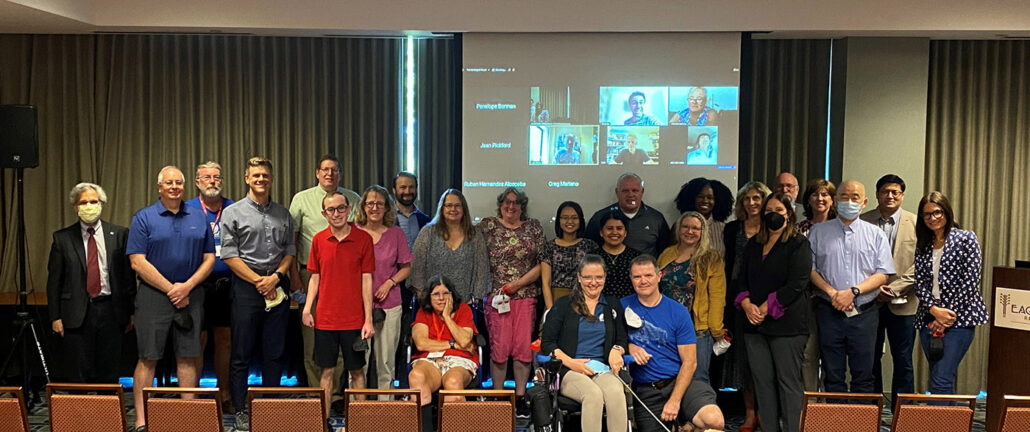
CTX Family Session Recap – June 24, 2022
at the ULF National Conference, Itasca, Illinois
Despite the ever-present concern that continually looms over our world about covid, the Cerebrotendinous Xanthomatosis (CTX) patient meeting was successful and well-attended. Precautions were taken and mask-wearing was the norm. There were forty people in attendance, in-person and virtually. The audience was comprised of patients, family members, physicians, researchers, collaborators, industry representatives and other CTX advocates. For a rare disease, this representation is quite amazing and a testament to the strong friendships within CTX community, desire to learn more, and dedication to help the CTX patient population.
Taking place between other leukodystrophy specific meetings, general sessions, and the lure of the green expansive onsite golf course, the CTX family meeting boasted a full agenda with expert speakers and updates on the latest CTX research. The meeting kicked off with a brief introduction from Jean Pickford, Executive Director of the CTX Alliance. Jean spoke about the organization’s formation last year, citing accomplished goals and future planning. It is remarkable to realize that less than 18 months ago there was no formalized patient group serving the needs of this rare disease community. Today, the CTX Alliance is an organized nonprofit with 101 members and world-class physicians and researchers leading the way for better care, access to treatments and newborn screening for CTX.
Jean opened the floor to questions from the attendees and recognized the CTX community leaders present in the room and participating by zoom. One important question came from an audience member who asked, “Who is the medical guru on CTX now? Dr. Gerald (Gerry) Salen used to be the expert until he passed away two years ago. Who has replaced him?” Dr. Bob Steiner, Professor at the University of Wisconsin
 School of Medicine & Public Health, Chief Medical Officer at Prevention Genetics, and Newborn Screening Program Medical Consultant for the Wisconsin Department of Health Services, and CTX board member, humbly recognized the pioneering impact of Dr. Salen and commented on how many patients and other physicians and researchers were affected by his work. Dr. Steiner then indicated the CTX Alliance has gathered CTX expert physician and researchers from around the world as part of the CTX Medical & Scientific Advisory Board (MSAB). This group is willing and readily accessible to answer patient questions and consult with other physicians about CTX. They can be reached through the CTX Alliance.
School of Medicine & Public Health, Chief Medical Officer at Prevention Genetics, and Newborn Screening Program Medical Consultant for the Wisconsin Department of Health Services, and CTX board member, humbly recognized the pioneering impact of Dr. Salen and commented on how many patients and other physicians and researchers were affected by his work. Dr. Steiner then indicated the CTX Alliance has gathered CTX expert physician and researchers from around the world as part of the CTX Medical & Scientific Advisory Board (MSAB). This group is willing and readily accessible to answer patient questions and consult with other physicians about CTX. They can be reached through the CTX Alliance.
The medical talks began shortly thereafter and were held to strict timelines, as the entire meeting was limited to three hours. Dr. Andrea DeBarber, Research Associate Professor at Oregon Health & Science University, who organized and chaired the session, introduced the first speaker, Dr. P. Barton Duell.
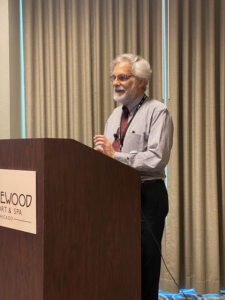 Dr. Duell, Professor of Medicine, School of Medicine, Oregon Health & Science University, kicked off the session with an introductory lecture on CTX. Dr. Duell shared that CTX is caused by pathogenic variants in the CYP27A1 gene and outlined the presenting symptoms and progression of symptoms with increasing age. He described the biochemistry and genetics of CTX and indicated the prevalence to be 3 to 5 per 100,000 individuals worldwide. Dr. Duell stated that, “It is a super hard path to get to the diagnosis, but the treatment is really easy. It is basically giving back what is needed.” He then talked about chenodeoxycholic acid, or CDCA, and the importance of early treatment. Dr. Duell mentioned that each patient may require additional treatments that are case-specific, and management of CTX complications takes a whole team of healthcare professionals.
Dr. Duell, Professor of Medicine, School of Medicine, Oregon Health & Science University, kicked off the session with an introductory lecture on CTX. Dr. Duell shared that CTX is caused by pathogenic variants in the CYP27A1 gene and outlined the presenting symptoms and progression of symptoms with increasing age. He described the biochemistry and genetics of CTX and indicated the prevalence to be 3 to 5 per 100,000 individuals worldwide. Dr. Duell stated that, “It is a super hard path to get to the diagnosis, but the treatment is really easy. It is basically giving back what is needed.” He then talked about chenodeoxycholic acid, or CDCA, and the importance of early treatment. Dr. Duell mentioned that each patient may require additional treatments that are case-specific, and management of CTX complications takes a whole team of healthcare professionals.
Next, Dr. Tzipora Falik Zaccai, Professor and Head of the Institute of Human Genetics at the Galilee Medical Center in Naharia Israel, and Vice Dean for Medical Research at the Azrieli Faculty of Medicine in Bar Ilan Israel, shared her experience on the use of CDCA therapy during pregnancy in CTX. In the US CDCA is contraindicated in women who are pregnant or may become pregnant, even though there is no available human data regarding its use during pregnancy. This contraindication was designated from animal testing experiments that showed some fetal harm from CDCA administered during pregnancy. Through her work and research of CTX patients who have become pregnant, Dr. Falik Zaccai has cared for several pregnant CTX patients treated with CDCA and has found good outcomes for mothers with CTX treated with CDCA, as well as their babies. Dr. Falik Zaccai will continue to add data to her study from additional pregnant CTX patients worldwide. Dr. Falik-Zaccai is very eager for this work to be published so that the treating physicians worldwide are confident to prescribe CDCA during pregnancy and deterioration of the disease in pregnant patients is avoided and the best health outcome is ensured for babies born to CTX mothers.
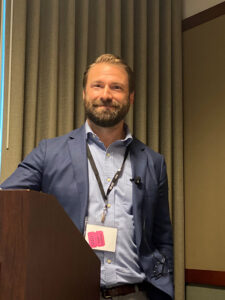 The third speaker was Dr. Brian Wishart, a physiatrist in the Leukodystrophy Clinic at Massachusetts General Hospital (MGH) in Boston, MA. Dr. Wishart presented his research over the past few years reviewing the literature on CTX and talking with CTX families about symptoms and management. The goal of his research is to expand the focus on under-appreciated symptoms in CTX and provide management recommendations for CTX. Dr. Wishart conducted a literature and chart review from 2016 on neurologic, psychiatric, and non-neurologic abnormalities and interventions. He presented a comparison chart of the literature findings and the findings for his cohort of patients in MGH’s leukodystrophy clinic. He stated the 100% of his patient cohort had some type of psychiatric symptom and that psychiatric symptoms in CTX have not been fully appreciated in the past. Dr. Wishart then discussed ataxia as a symptom of CTX and how this symptom can be complicated to treat and manage. He gave examples of bracing types and how these techniques can help to maximize the use of muscles for greater stability.
The third speaker was Dr. Brian Wishart, a physiatrist in the Leukodystrophy Clinic at Massachusetts General Hospital (MGH) in Boston, MA. Dr. Wishart presented his research over the past few years reviewing the literature on CTX and talking with CTX families about symptoms and management. The goal of his research is to expand the focus on under-appreciated symptoms in CTX and provide management recommendations for CTX. Dr. Wishart conducted a literature and chart review from 2016 on neurologic, psychiatric, and non-neurologic abnormalities and interventions. He presented a comparison chart of the literature findings and the findings for his cohort of patients in MGH’s leukodystrophy clinic. He stated the 100% of his patient cohort had some type of psychiatric symptom and that psychiatric symptoms in CTX have not been fully appreciated in the past. Dr. Wishart then discussed ataxia as a symptom of CTX and how this symptom can be complicated to treat and manage. He gave examples of bracing types and how these techniques can help to maximize the use of muscles for greater stability.
Next Dr. Penelope Bonnen, a faculty member in the Department of Molecular and Human Genetics at Baylor College of Medicine, presented on the genetics and incidence of CTX and shared evidence to support similar progression of CTX within families. CTX has been considered to be an ultra-rare disease. Dr. Bonnen and her team applied different approaches to determine incidence. Their calculations using population genetic and bioinformatic approaches indicated that the CTX incidence is higher than previously thought (1:135,000 – 1:460,000 in White; 1:260,000 – 1:470,000 in Black; and 1:64,000 – 1:75,000 in Asian populations). Dr. Bonnen also discussed the clinical presentation of CTX in families. Her data indicated that disease presentation in affected family members is more similar than different, and that most affected individuals within the same family experience the same major clinical features, although the severity of features and age of onset vary greatly.
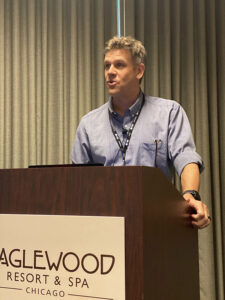 The last three talks focused on ongoing research to support implementation of newborn screening for CTX. Dr. Austin Larson, is a faculty member at the University of Colorado School of Medicine and practices at Children’s Hospital Colorado. Dr. Larson maintains board certification in pediatrics, medical genetics, and biochemical genetics. Dr. Larson’s lecture was titled “CTX Systematic Evidence Review – a Resource for Consideration of CTX for Newborn Screening.” He shared results from a collaborative systematic evidence review of published CTX cases that can be used as a resource to help answer questions posed by the Secretary’s Advisory Committee on Heritable Disorders in Newborns and Children (SACHDNC) after the first unsuccessful nomination submission for CTX to be added to the federally Recommended Uniform Screening Panel (RUSP) of disorders screened for in newborns. The SACHDNC asked for additional evidence to be provided, including, 1) finding an identifiable CTX affected newborn in prospective pilot studies screening newborn dried bloodspots, 2) clarification of a case definition for CTX with additional data on the spectrum of the disease, and 3) to provide evidence of benefit of identification of affected newborns and early treatment. The systematic evidence review identified 248 publications that described 1054 separate CTX patients. These patients were then narrowed down to 873 who had usable clinical data for the study and 475 with a genetic diagnosis. Dr. Larson presented data from this patient cohort and compared it to other publication’s describing characteristics for larger patient cohorts. This study includes data from the largest number of CTX patients identified so far. It should help researchers answer some of the questions posed by SACHDNC. More work still needs to be done and the next steps include analyzing the data to identify any genotype-phenotype correlations.
The last three talks focused on ongoing research to support implementation of newborn screening for CTX. Dr. Austin Larson, is a faculty member at the University of Colorado School of Medicine and practices at Children’s Hospital Colorado. Dr. Larson maintains board certification in pediatrics, medical genetics, and biochemical genetics. Dr. Larson’s lecture was titled “CTX Systematic Evidence Review – a Resource for Consideration of CTX for Newborn Screening.” He shared results from a collaborative systematic evidence review of published CTX cases that can be used as a resource to help answer questions posed by the Secretary’s Advisory Committee on Heritable Disorders in Newborns and Children (SACHDNC) after the first unsuccessful nomination submission for CTX to be added to the federally Recommended Uniform Screening Panel (RUSP) of disorders screened for in newborns. The SACHDNC asked for additional evidence to be provided, including, 1) finding an identifiable CTX affected newborn in prospective pilot studies screening newborn dried bloodspots, 2) clarification of a case definition for CTX with additional data on the spectrum of the disease, and 3) to provide evidence of benefit of identification of affected newborns and early treatment. The systematic evidence review identified 248 publications that described 1054 separate CTX patients. These patients were then narrowed down to 873 who had usable clinical data for the study and 475 with a genetic diagnosis. Dr. Larson presented data from this patient cohort and compared it to other publication’s describing characteristics for larger patient cohorts. This study includes data from the largest number of CTX patients identified so far. It should help researchers answer some of the questions posed by SACHDNC. More work still needs to be done and the next steps include analyzing the data to identify any genotype-phenotype correlations.
 The next speaker was Dr. Frederic Vaz, a researcher in the Laboratory of Genetic Metabolic Diseases in Amsterdam, Netherlands. Dr. Vaz presented a lecture entitled, “CTX On the Way to Newborn Screening: Validation of Two Methods in 20,000 Dried Blood Spots.” He provided a brief overview of prior work that led up to this point, including the fact the Dutch screening program already considered CTX as a viable candidate for newborn screening, but there was no appropriate test available. This prompted Dr. Vaz and other colleagues to successfully design an assay to screen dried blood spots for CTX using bile tetrol glucuronide and tauro-CDCA biomarkers. This test was successfully used by Dr. Michael Gelb, who screened 35,000 newborn dried blood spots and found one CTX screen-positive and a zero false-positive rate. Dr. Vaz received funding from the Dutch government to screen 20,000 newborn dried blood spots using two methods: flow injection analysis (FIA) with tandem mass spectrometry (MS/MS) detection and liquid chromatography (LC)-MSMS. No CTX positive samples were identified. Both assays look promising, but more work needs to be done to determine the exact cutoff values to identify CTX positive samples. To do this it will be important to obtain newborn dried blood spots from real CTX patients and this is where the CTX patient community can help. Dr. Vaz indicated that he and his team are looking forward to formal endorsement of their method by the RIVM-Centre for Population Screening and he anticipates the Netherlands will initiate newborn screening for CTX in due course.
The next speaker was Dr. Frederic Vaz, a researcher in the Laboratory of Genetic Metabolic Diseases in Amsterdam, Netherlands. Dr. Vaz presented a lecture entitled, “CTX On the Way to Newborn Screening: Validation of Two Methods in 20,000 Dried Blood Spots.” He provided a brief overview of prior work that led up to this point, including the fact the Dutch screening program already considered CTX as a viable candidate for newborn screening, but there was no appropriate test available. This prompted Dr. Vaz and other colleagues to successfully design an assay to screen dried blood spots for CTX using bile tetrol glucuronide and tauro-CDCA biomarkers. This test was successfully used by Dr. Michael Gelb, who screened 35,000 newborn dried blood spots and found one CTX screen-positive and a zero false-positive rate. Dr. Vaz received funding from the Dutch government to screen 20,000 newborn dried blood spots using two methods: flow injection analysis (FIA) with tandem mass spectrometry (MS/MS) detection and liquid chromatography (LC)-MSMS. No CTX positive samples were identified. Both assays look promising, but more work needs to be done to determine the exact cutoff values to identify CTX positive samples. To do this it will be important to obtain newborn dried blood spots from real CTX patients and this is where the CTX patient community can help. Dr. Vaz indicated that he and his team are looking forward to formal endorsement of their method by the RIVM-Centre for Population Screening and he anticipates the Netherlands will initiate newborn screening for CTX in due course.
Our final speaker was Dr. Joseph Orsini, Deputy Director of the Newborn Screening Program at the New York State Department of Health’s Wadsworth Center, who gave an update on the prospective pilot study screening newborns in New York state for different disorders (ScreenPlus study). The study is a consented population-based research study to assess the suitability of specific disorders for public health mandated screening, including long-term follow-up and ethical, legal, and social issues studies. CTX is one of fourteen disorders that they are screening for in this project. The goals of the ScreenPlus study are to evaluate the validity of the screening assays and possibly define disease incidence rates, collect data about how well children do with early detection, and examine the ethical, legal, and social issues (ELSI) associated with screening newborns for complex disorders. The fourteen diseases included in the pilot project needed to meet certain criteria and there are three tiers of testing for each disorder to enhance accuracy. Some of challenges have been that currently only one out of ten hospitals who agreed to be a part of this project is active, but remaining required contracts are being put in place and study coordinators are being hired. COVID stalled progress for the study. ELSI considerations being examined include once a child has been identified through the screening, what should the follow-up protocol be for families? Also how do families feel about having diseases detected that may not present until later in life? Dr. Orsini shared that there are improvements still needed on the testing methodology side, particularly in the areas of method validation and quality assurance. He also shared that this pilot screening project is less than perfect because they are testing for fourteen disorders, which prompts the following question: Is it better to run many less than perfect tests, setting up for increased false positive results, to improve the chances of detecting someone with a disease that can be treated? There will be more to come on this project in the coming months.
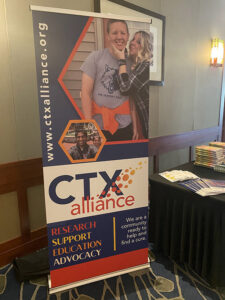 There certainly was a lot of information provided in just a short amount of time, and speakers fielded questions from the in-person audience and virtual attendees. Before the meeting broke up, Jean gathered all attendees in front of the virtual participants and took a group photo. Small clusters of patients and physicians formed for personal chats and questions, and everyone was invited to join at CTX designated tables for lunch.
There certainly was a lot of information provided in just a short amount of time, and speakers fielded questions from the in-person audience and virtual attendees. Before the meeting broke up, Jean gathered all attendees in front of the virtual participants and took a group photo. Small clusters of patients and physicians formed for personal chats and questions, and everyone was invited to join at CTX designated tables for lunch.
Later in the day, the conference organizers provided small meeting rooms for each disease specific group to gather for informal, private discussions amongst each other. About 25 CTX patients, caregivers, and a few physicians moved their chairs to form a circle for easier conversation. It was quiet at first and no one knew quite what to say. But quickly a leader emerged and suggested to go around the circle and introduce each other and share a little about their CTX journey. Within minutes, the floodgates opened, and everyone was sharing triumphs, challenges, lessons, and inspiring stories. Suggestions, advice, and caring support was exchanged, and the camaraderie was inspiring and heartfelt. This session provided an outlet for free exchange between people who understand and get “it,” which prompted discussion to start an online support group via zoom.
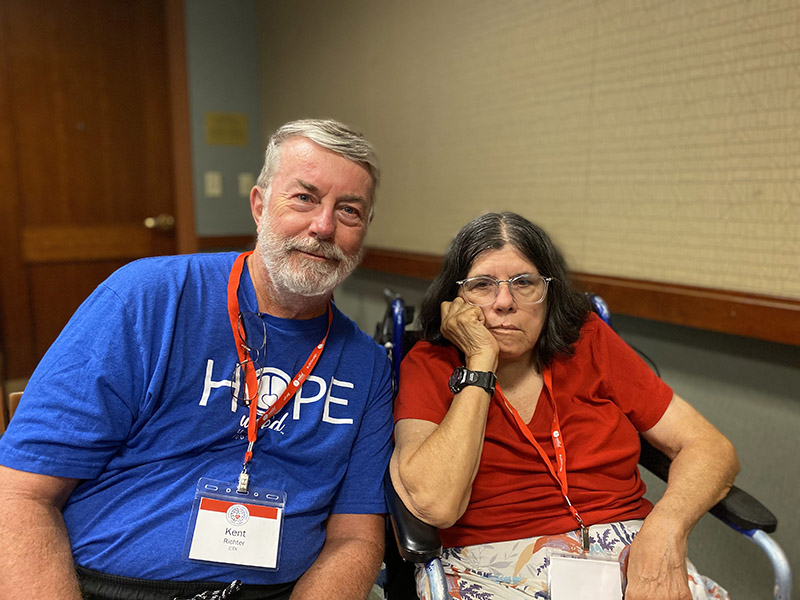


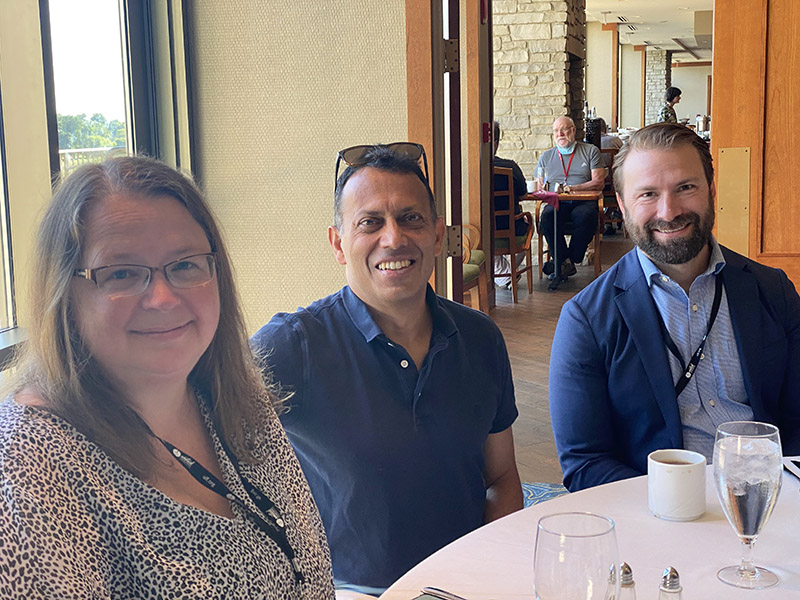


The CTX Alliance has started to plan next year’s conference and have new ideas to make it even more impactful. The hope is to double the number of participants in 2023 and leverage the unique opportunity to gather, learn, and share. In the world of rare diseases, this information and interaction is immeasurable.
Join The CTX Alliance
Join our mailing list to receive information and news as we begin to gather and expand the CTX community.
Support the CTX Alliance
1586 Sumneytown Pike
PO Box 1322
Kulpsville, PA 19443
info@ctxalliance.org
Latest CTX Articles
- Allelic prevalence and geographic distribution of cerebrotendinous xanthomatosis March 17, 2025
- Chenodeoxycholic acid (CDCA) treatment during pregnancy in women with cerebrotendinous xanthomatosis (CTX): Lessons learned from 19 pregnancies March 17, 2025
- Cerebrotendinous Xanthomatosis occurs at high frequency in Ashkenazi Jews March 17, 2025
